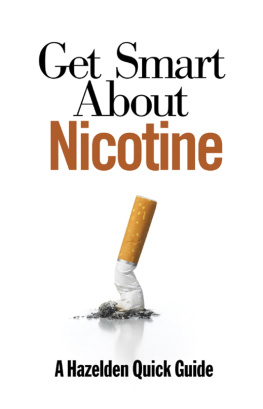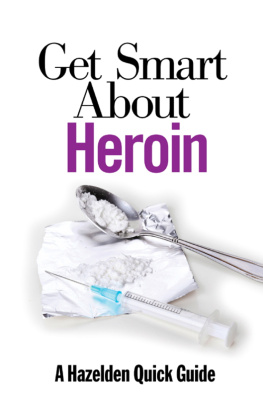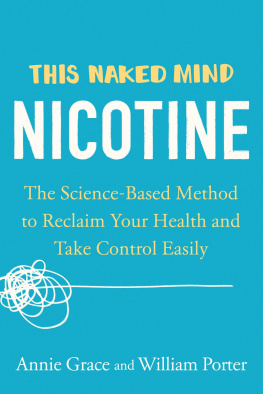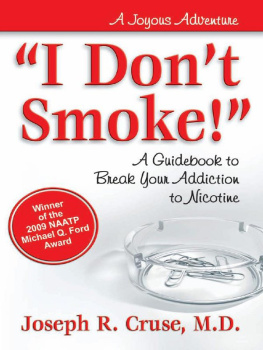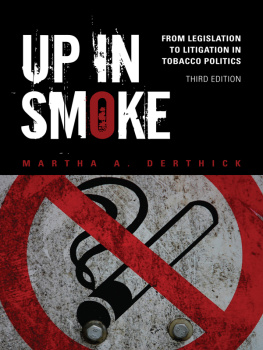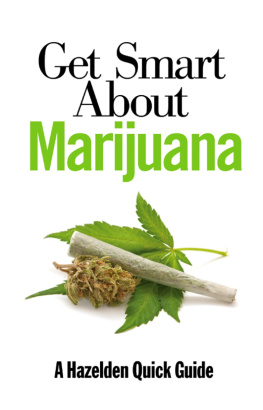Get Smart About Nicotine
A Hazelden Quick Guide

Hazelden Publishing
Center City, Minnesota 55012
800-328-9000
hazelden.org/bookstore
2013 by Hazelden Foundation
All rights reserved. Published 2013.
No part of this publication may be reproduced in any form or by any means without the express written permission of the publisher. Failure to comply with these terms may expose you to legal action and damages for copyright infringement.
Library of Congress Cataloging-in-Publication Data [to come]
eISBN 978-1-61649-518-3
Editors notes:
The names, details, and circumstances may have been changed to protect the privacy of those mentioned in this publication.
This publication is not intended as a substitute for the advice of health care professionals.
Alcoholics Anonymous is a registered trademark of Alcoholics Anonymous World Services, Inc.
17 16 15 14 13 1 2 3 4 5 6
Cover design by Theresa Jaeger Gedig
Interior design and typesetting by BookMobile Design & Digital Publisher Services
Developmental editor: Peter Schletty
About Hazelden Quick Guides
Hazelden Quick Guides are short, accessible e-books that draw on the original work and best practices of leading experts to help readers address common addiction recovery and emotional health issues. The Get Smart collection describes each of the major drugs, its historical, cultural, and legal context, its addictive qualities, and information on prevention and treatment.
Introduction
People have been using tobacco products in some manner or another since the early 1500s, though the history goes well beyond that. At one point, smoking was the norm in our culture, even a coming-of-age transition. A culture shift that began fifty or more years ago, backed by science and research, has dramatically reduced the number of people who use tobacco in the United States. Yet the problem persists, striking costly blows to our health and economy, and every new user is likely to become hooked on nicotine. The recent introduction of new smokeless forms of tobacco presents new challenges to the antitobacco movement. This e-booklet will explore the long history of tobacco, its cultural influences, and the nature of nicotine addiction. Well also discuss different routes to recovery and why prevention is so critical with this drug.
History
Tobacco: Americas Gift to the World
History tells us that Columbus and other early explorers were searching for a new route to Asia, as well as riches such as gold and spices, when they stumbled upon the New World. Who knew that one discovery of this era, the tobacco plant, would have such a profound effect on the worldand such devastating health consequences. Columbus is said to have had his first glimpse of tobacco when he stepped onto a small island in the Bahamas and the locals offered him dried tobacco leaves. Again and again, he and his crew witnessed natives using this plant and decided to bring it back with them to Spain.
A plant native to the Americas, tobacco was in use long before the European explorers caught sight of it. Archaeologists trace tobacco to the Andes area of South America, where it was first cultivated between 5000 and 3000 BCE. From there, the plant spread northward. Drawings carved in stone reveal that the Mayans used tobacco somewhere between 600 and 900 AD. By the time Columbus arrived in the region in 1492, tobacco use had spread throughout the Americas and to the Caribbean Islands.
When tobacco was introduced to Europeans, the medicinal value of the plant was of keen interest. This was an era where doctors would typically treat patients with various oils or herbs. And, unlike most plants that were thought to heal a specific ailment, tobacco was tested as a remedy for maladies and injuries of virtually all forms. Among other applications, it was ground up and swallowed or placed upon wounds. Before long, Europeans considered it a panacea and used it to treat everything from tumors to ringworm to the plague. In 1560, a French ambassador was introduced to tobacco while in Portugal; he brought the plant back with him and gave it to the queen, who suffered from migraines. The ambassadors name was Jean Nicot, and cultivated tobacco eventually took on the scientific name Nicotiana tabacum.
Tobacco was not limited to medicinal use. Explorers to the New World had seen the natives smoking tobacco in pipes of various shapes and sizes. With this in mind, they began smoking the dried leaves as well; eventually, they also chewed it and later rolled and smoked it. By the mid-1500s tobacco was well known for its pleasurable effects.
Yet, even from the beginning, tobacco had its critics. King James I of England was one. In 1604, he raised the import tax on tobacco forty-fold and wrote a book lambasting its effects, A Counterblaste to Tobacco. In 1610, Sir Francis Bacon wrote about its habit-forming characteristics that were difficult to break. In time, doctors began questioning how effective tobacco was as a therapy. By the end of the seventeenth century, its perceived value as an effective pharmaceutical was in decline, though the pharmacies of the day still made it available. Still, cure-all or not, tobacco was to retain a prominent role on the continent and beyond.

Native Americans and Tobacco
Throughout history Native American peoples have used tobacco in their spiritual ceremonies and rituals. They have also used it for medicinal purposes. And though Columbus and his companions witnessed Native American peoples enjoying tobacco as a part of their rituals, they did not smoke it every day.
Most Native Americans smoked tobacco in a pipe, which calls to mind the peace pipe that is used during ceremonies and symbolizes respect for one another. Smoking tobacco in a pipe still remains an important part of many Native American ceremonies, but many Native Americans now smoke cigarettes and use other recreational forms of tobacco as well.

When King James granted the Virginia Company of London permission to become the first English colony in the New World, profit was one of the things on his mind. The colonists arrived in 1607 but were unable to make use of the riches of this new land. It wasnt until 1610 with the arrival of John Rolfe, who would eventually marry Pocahontas, that the colonists turned their efforts toward growing and exporting tobacco. As a lucrative, in-demand crop, tobacco was also one of the keys to the colonys survival.
Tobacco continued to grow in importance in the Virginia colony. The rise of tobacco plantations, and the necessary labor for growing and harvesting the crop, would even be a factor in the development of slavery.
While the Virginia Company may have been the first to profit from tobacco in the New World, others were soon to follow. Today, the United States largest producers of tobacco are North Carolina, Kentucky, Virginia, and Tennessee. Although small family tobacco farms have become rare and tobacco production in the United States has declined since the 1950s, it has grown throughout the world. The production of cigarettes increased with advances in technology and agriculture. Today, tobacco is produced in almost every nation, with an annual output of approximately six trillion cigarettes.

